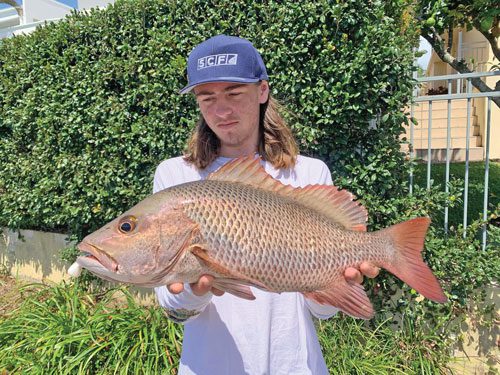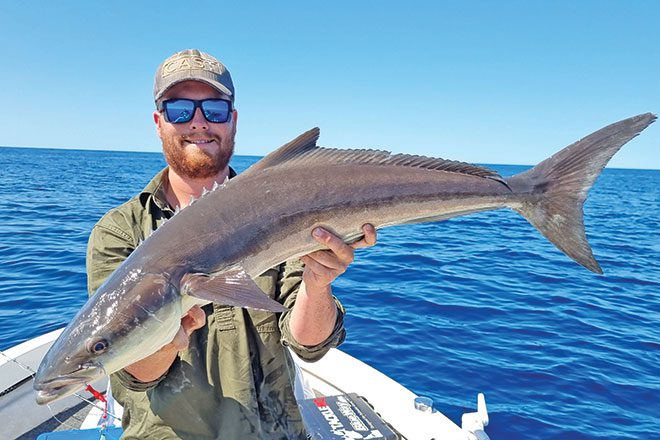November is a great time to be an angler, with the start of the warmer weather. The wind tends to blow from the north, which gets the air temperature up and the barramundi anglers excited.
Our pelagic fish start showing up, especially around Hervey Bay, K’gari and down towards us in southeast Queensland. For those fishing offshore, the fish aggregating devices also begin showing signs of life after a gentle start in October.
With typical water temperature expected to hit about 24-25C, this is a trigger for pelagic fish and other speedsters to commence filtering across our region.
For now, spanish mackerel may be in close around the shallower reefs, especially if we have a big bump in air temp. If you have a kayak, big troll bait of bonito rigged on stinger rigs works very well.
The kayak fraternity often set the pace for other anglers because they have stealth on their side. Double Island is often worth the additional journey time from Noosa, or drive to Tin Can Bay and cross the bar there.
Red emperor, amberjack, trevally, snapper, pearl perch, nannygai and jewfish are often found in theses areas, along with a range of other species. You can drop huge slab bait to the bottom for reds or drift with soft plastics and jigs in these spots.
If drifting, you’ll want something such as a Storm Gomoku Koika jig or a minnow-style plastic such as a Z-Man StreakZ, as these fall quickly enough for vertical fishing applications.
For those staying local, North Reef has been holding a great mixed bag of species, with jewfish around the 1m mark.
These fish turned up in spring along with cobia in good numbers and will eat almost anything. If lure fishing, I prefer to target jew on 20lb gear and a soft plastic of your choice.
I find the jig head weight more important than the plastic type. If in deeper water, 3/4oz to 1 1/2oz works best. This lets you adapt to current, wind or a mixture of both. Ensuring your plastic has sufficient fall time after you work it is paramount to success.
Cobia love plastics and jigs on slightly heavier 30-40lb gear. They enjoy a wide range of bait, including live, slab and strip on a snelled 7/0 octopus circles and 60lb leader.
Live bait have a habit of drawing out the bigger fish, so always try to get their heads turned early on and don’t stop!
While snapper, cobia, tuna and mackerel are present, it is always a great idea to have a pilchard floater out. These work well on shallower parts of Sunshine Reef.
During light wind and current days, a light berley trail can definitely fire the fish up. Be sure to pick up some pellets, tuna oil, aniseed oil and mix it with pilchard and sand for a killer berley mix.
Sunshine Reef is the place for big coral trout, grass sweetlip, snapper, cobia and even an occasional marlin. Out here a mix of styles can be used, with 20lb setups perfect for soft plastics and lighter 40-80g Samaki Wingman jigs.
Dropping live bait works very well for trout, but the leader needs to be increased to 60lb or more because this part of the reef can be very unforgiving. As things warm up, the headlands are a great place to cast larger stickbaits such as the Oceans Legacy Keeling 45g on lighter PE3 casting outfits.

If mackerel are about, you may want to take a few lures with you. The rewards are there, with many big 20kg plus tuna caught alongside mackerel and even cobia.
Elsewhere dart, whiting and trevally can be found in the gutters and holes from Teewah heading north to Double Island. Closer to the river mouth, the middle groyne in Noosa, smaller mackerel, dart, flathead, bream and trevally can be expected.
For those wanting to catch mackerel, you can try a gang-hooked pilchard or metal slug from Gillies, as these will cast the distance. For estuary anglers, mangrove jack are high on the target list.
These fish are power houses and must be experienced if you fish the estuary. These fish can easily be caught on a live bait, but to target them on lures requires more skill, with more satisfaction once caught.
Learning where they hang out is important but know that Noosa has many areas for them to lay in wait. Casting or slow-trolling hard-body lures, casting soft vibes and working soft plastics all works well and we have a huge array of options on offer.
Angling at night can be very productive as jacks will often break from cover under the night sky. Many anglers see these fish as prized sport fish, with most returned only to be caught repeatedly before they head offshore to live.
Mangrove jack must head offshore to breed, so please consider your bag limits before keeping them because they are certainly too good to catch only once.
Big flathead can be found in the lower part of the river, particularly at this time of year. Big female fish come down the river mouths to breed and as such, fish over 90cm can be caught.
They respond well to shallow-trolled hard-body lures and slow-wound soft plastics.
Night fishing can also be very productive, with big prawns and paddle tail soft plastics. Keitech 5” Easy Shiner in Sight Flash colour is one such option. You can also expect to catch the occasional jack.
Having a big landing net is important if you intend to target these big fish, as many are lost at the boat or bankside. Top tip when fishing at night is to limit noise and light.
Do not arrive at your spot under full power with a torch scanning over the water and throw an anchor out. This shuts the fish down and moves them on, so if you can approach under the power of an electric motor and use your mapping or GPS to navigate, you can expect better results.
Be sure to check out Minn Kota in Davo’s Boating & Outdoors, which is next to Tackle World at Noosa.
Daytime angling will see bream, whiting, flathead, trevally and perhaps a jack in the Frying Pan and dog beach snags. Surface lures are a lot of fun for whiting and trevally when skipped across the flats.

The Zip Baits Skinny Pop is a classic lure to raise packs of whiting, trevally, tailor and bream. Flats fishing requires polaroid glasses to cut through the glare. We stock a wide range of Spotters, Maui Jim and Smith sunglasses, so we have you covered.
For bait anglers, a simple running sinker rig with some red whiting tube and a live worm works wonders. Freshwater has been nothing short of tough, due to the winter flooding. This saw many fish lost over dam walls and a huge recruitment into major rivers.
Though tough, fish are still in these dams, and the warmer weather and – fingers crossed – lack of rain should see them fire up. When on the water, try to find the cleaner warmer water and start your session there.
If we see a spike in temperature and a northerly wind, there should be a good surface bite period. Keeping lures small is probably going to work best, with Lucky Craft Sammy 65 and Atomic Hardz K9 Walkers.
Once the sun is up, try using jerk baits around the edges. A great thing about the flooding was that the weed that had chocked many areas up was washed away, which has made fishing the edges possible.
Lastly, a great feature of November is that the barramundi dams should start to fire up, with this month a great time to experience 20kg fish. Come in and grab a few Jackall Squirrel jerkbaits, Molix Shad 140mm swimbaits and some weedless hooks for fishing the timber.
Now, for all the latest information, log onto fishingnoosa.com.au for up-to-date bar and fishing reports, don’t forget to drop into Tackle World Noosa, Noosa Boating and Outdoors and
Northshore Bait & Tackle in Marcoola for all the right equipment, bait and advice to get you catching.
Be sure to follow us on Facebook and remember, tight lines and bent spines!
 Bush 'n Beach Fishing Magazine Location reports & tips for fishing, boating, camping, kayaking, 4WDing in Queensland and Northern NSW
Bush 'n Beach Fishing Magazine Location reports & tips for fishing, boating, camping, kayaking, 4WDing in Queensland and Northern NSW








